Scott Janus lead the technical session today. He is the Media Architect for Intel, an accomplised author, and has been around since the i740 graphics product about a decade ago.
Performance-

The conference started out with an overview of why the personal computer is becoming an important tool for watching video. A theme that carried over from the keynote speeches this morning. In fact, the latest studies show the average user watches 228 minutes of video over the internet each month. Also, just in the US, we viewed over 12 billion videos online in May of this year alone. Besides watching videos online, viewing high definition content is becoming increasingly important.
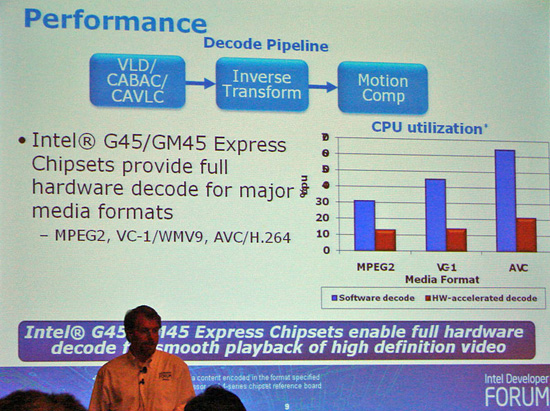
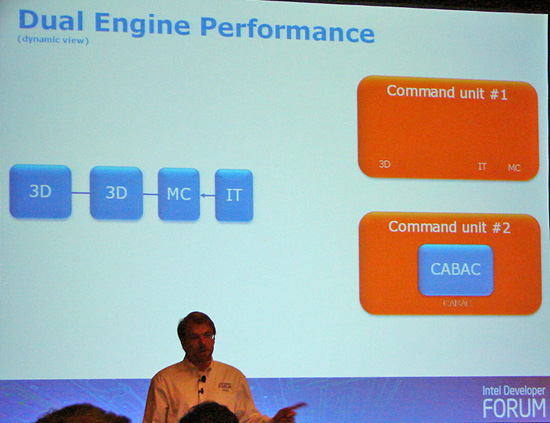
The session started to get interesting as Scott delved into some of the unique performance features of the G45 family. Unlike previous Intel chipsets, the G45 series offers full hardware decode capabilities for MPEG2, VC-1/WMV9, and now AVC/H.264. CPU utilization rates are down significantly now with H.264 dropping down around 20% compared to 75% in our testing, results similar to Intel.
One of the performance enhancements that Intel designed into the G45 is the Dual Engine layout (balanced parallel decode engines). This design is different from previous Intel chipsets as it features two Command units. The first command unit will complete 3D layer, motion compensation, and inverse transform tasks while the second command unit will work exclusively on CABAC (context-adaptive binary arithmetic coding) routines.
CABAC is one of the more popular video encoding algorithms due to superior compression techniques in AVC/H.264 encoding. CABAC routines require an extensive amount of processing power during the decode process compared to similar algorithms. As such, Intel determined one of the best ways to improve performance and reduce power is to send CABAC routines to a second command unit.
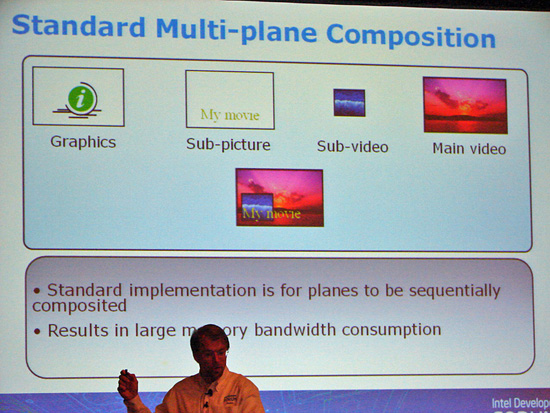
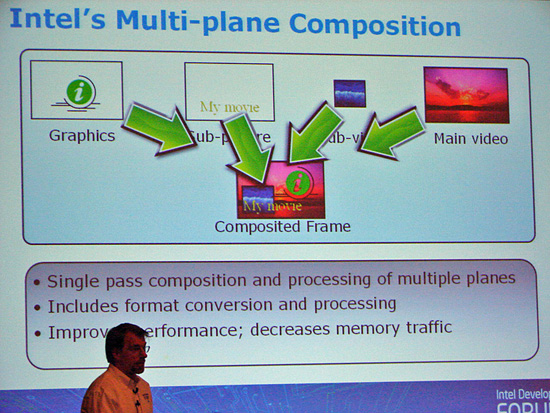
Another performance enhancing technique that Intel implemented is a Multi-plane composition routine that features single pass composition and processing of multiple planes along with format conversion and processing. Compared to the standard Multi-plane composition technique that requires the various planes to be sequentially composited, the new routine decreases memory bandwidth requirements significantly.
Power Efficiency-
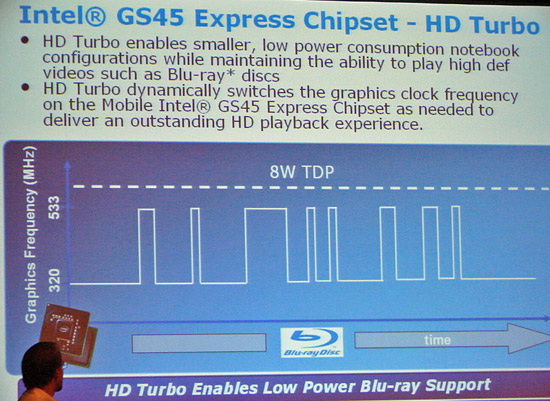
For the notebook crowd, Intel looked at various ways to reduce power during high-definition content playback. One of the features added to the GS45 mobile chipset is a function called HD Turbo. This feature dynamically switches the graphics core clock frequency as needed to ensure proper HD playback. The range allowed is anywhere from 320 MHz to 533 MHz. Also featured is version 4 of DPST (Display Power Saving Technology) that dynamically controls picture brightness by influencing backpanel lighting. All together, these new features allow the GS45 chipset to reach a 150 minute range when playing back a typical H.264 title compared to 104 minutes with the previos GM965 chipset utilizing a 58W per hour battery setup.
Did we get our questions answered?
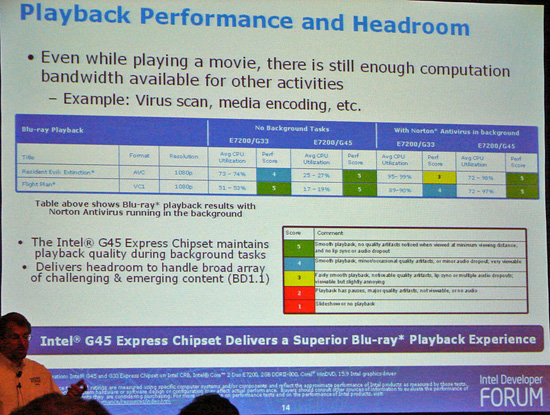
Intel made a point that the G45 is capable of playing back high-definition content while performing other tasks. To prove their point, they presented an interesting demo that featured the Blu-ray and SD versions of Batman Begins each playing at the same time along with Blu-ray picture-in-picture playback. Of course, we have had this capability from AMD and NVIDIA for several months but the G965/G35 could not handle this task. What really made the demo interesting was the video/audio output being sent to the Onkyo TX-SR605 and then out to the display and speakers via HDMI.
That's right, repeater mode is finally working. After a closer inspection of the display output, de-interlacing and post processing is now active. However, 1080P/24Hz playback support is still not working properly. Before getting too excited, this demo was presented with the new 15.11 drivers (newer than the 7/26 release) and a beta version of Corel WinDVD 9.0 Plus. The upgraded 15.11 driver set will be released this week, but we still do not have a firm release schedule from Corel, Cyberlink, or ArcSoft on patches to their BD capable products that feature full repeater and Intel Clear Video support.
Even though repeater mode is working correctly in the press demos, we are still not sure about full repeater support for the most popular receivers from Denon, Pioneer, Sony, or Yamaha as Intel has only tested this feature on models from Onkyo and Astro. Until we have proper software support, this platform will continue to be crippled for the serious HTPC user. That's a shame really as this chipset has tremendous potential for the HTPC market. Look for our G45 review shortly and hopefully we will have some good news regarding software updates by then.










12 Comments
View All Comments
ianken - Sunday, August 24, 2008 - link
Intel has notoriously sucked for HTPC applications. They constantly promise all this awesome media-centric stuff then deliver integrated solutions that just don't work.ianken - Sunday, August 24, 2008 - link
Replying to my own post: one more thing: dymanic picture adjustment BS features are lame.Video is a well speced technology. How you decode and render broadcast video is not up for interpretation. Any "dynamic" bs feature is just that.
As long as they allow you to turn it off, then fine. Anyone who's struggled with AMDs "AVIVO" video mangling noise reduction knows what I mean.
LoneWolf15 - Friday, August 22, 2008 - link
"Unlike previous Intel chipsets, the G45 series offers full hardware decode capabilities for MPEG2, VC-1/WMV9, and now AVC/H.264. CPU utilization rates are down significantly now with H.264 dropping down around 20% compared to 75% in our testing, results similar to Intel."Don't you mean "results similar to ATI"?
(P.S. I'd have used the Quote button, but it doesn't seem to be working for me).
ltcommanderdata - Friday, August 22, 2008 - link
I believe they meant that their own independent results were the same as Intel's. So Intel's claims about the G45 are accurate.iwodo - Thursday, August 21, 2008 - link
I hope a few questions can be answered in the G45 article.Using 20% CPU for full decode is a lot better then previous Intel iGfx 75%. But that is under which CPU unit? A Core2Duo E8xxx? Or a Celeron?
Compare to other iGFX which can decode 1080p with a single Digit CPU usage it isn't that much better.
And did Intel promise to put more resources into driver development? Their hardware can only ever be as good as their drivers. Even tough Intel have nearly 50% of graphics market share they are putting the LEAST effort into their drivers.
gwynethgh - Thursday, August 21, 2008 - link
"However, 1080P/24Hz playback support is still not working properly"Any clues when this will be corrected? Is it a G45 hardware bug or just software
Badkarma - Thursday, August 21, 2008 - link
Gary,I'd like to see an option for Desktop levels to be set to 16-235 as well as Video levels to 16-235. With current drivers for ATI/Nvidia and I assume Intel, Desktop levels are always 0-255, and Video can be set to 16-235, however when connected to a TV that is expecting Video levels(16-235), Desktop work or playing games will always be clipped. It'd be great to have the option to set everything to Video levels when sent to a TV set.
sprockkets - Thursday, August 21, 2008 - link
Intel seems oblivious to the fact that the CoreAVC codec in software has been beating "hardware" solutions for sometime. Not saying I'd rather have that than a G45, cause Intel has a G45 mini-ITX board for $150.Chriz - Thursday, August 21, 2008 - link
Did Intel happen to mention at these meetings why their Intel branded P43/45 and G43/45 motherboards are not available from anywhere while most other motherboards manufactured by other companies are?JarredWalton - Thursday, August 21, 2008 - link
"Also featured is version 4 of DPST (Display Power Saving Technology) that dynamically controls picture brightness by influencing backpanel lighting."So I have to ask, is there *anyone* out there that likes dynamic contrast/backlighting algorithms? Every display/laptop I've tested that offers the technology results in an unpleasant darkening/lightening of the screen. It's extremely distracting and one of the first things to get shut off if it comes enabled by default.